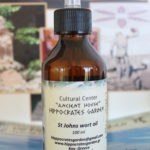Description
St. John’s wort is a plant with yellow, star-shaped flowers and five petals that grows in Europe, North and South America, Australia, New Zealand, and Eastern Asia. The plant grows in sunny, well-drained areas. It grows to be 50-100 cm tall.
St. John’s wort might cause serious interactions with some drugs. Because of this, France has banned the use of St. John’s wort in products. Several other countries, including Japan, the United Kingdom, and Canada are in the process of updating warning labels on St. John’s wort products.
St. John’s wort is most commonly used for depression and conditions that sometimes go along with depression such as anxiety, tiredness, loss of appetite and trouble sleeping. There is some strong scientific evidence that it is effective for mild to moderate depression.
Other uses include heart palpitations, moodiness and other symptoms of menopause, mental disorders that present physical symptoms, premenstrual syndrome (PMS), attention deficit-hyperactivity disorder (ADHD), obsessive-compulsive disorder (OCD), social phobia, and seasonal affective disorder (SAD).
St. John’s wort has been tried to help quit smoking, for fibromyalgia, chronic fatigue syndrome (CFS), burning feelings in the mouth, migraine and other types of headaches, muscle pain, nerve pain and nerve damage throughout the body, pain that travels down the sciatic nerve in the leg, and irritable bowel syndrome. It is also used for cancer (including brain cancer), HIV/AIDS, hepatitis C, herpes simplex, to help with a procedure to unblock clogged arteries, weight loss, and to treat a disease that causes the skin to lose color.
An oil can be made from St. John’s wort. Some people take this oil by mouth for indigestion. Some people apply this oil to their skin to treat bruises and scrapes, inflammation and muscle pain, scaly and itchy skin (psoriasis), first degree burns, wounds, tooth pulling, bug bites, hemorrhoids, nerve pain, and to treat a disease that causes the skin to lose color. But applying St. John’s wort directly to the skin is risky. It can cause serious sensitivity to sunlight.
In manufacturing, St. John’s wort extracts are also used in alcoholic beverages.
The active ingredients in St. John’s wort can be deactivated by light. That’s why you will find many products packaged in amber containers. The amber helps, but it doesn’t offer total protection against the adverse effects of light.
How does it work?
For a long time, investigators thought a chemical in St. John’s wort called hypericin was responsible for its effects against depression. More recent information suggests another chemical, hyperforin, as well as adhyperforin, and several other similar chemicals may play a larger role in depression. Hyperforin and adhyperforin act on chemical messengers in the nervous system that regulate mood.
St. John’s wort oil is one of my most used home remedies! It is a superb massage oil; but it also helps with cuts, scrapes, minor burns, sore muscles and growing pain. St. John’s wort oil is an amazing home remedy for minor burns. It helps to stop the pain and heal the burn. I have multiple stories about people who have turned their first degree burns. St. John’s wort oil also helps with muscle strain and tension. The more you use it, the better it is. You can massage it into tense, sore muscles several times a day and it helps to relax the muscles.
St. John’s wort is a plant with yellow, star-shaped flowers and five petals that grows in Europe, North and South America, Australia, New Zealand, and Eastern Asia. The plant grows in sunny, well-drained areas. It grows to be 50-100 cm tall.
St. John’s wort might cause serious interactions with some drugs. Because of this, France has banned the use of St. John’s wort in products. Several other countries, including Japan, the United Kingdom, and Canada are in the process of updating warning labels on St. John’s wort products.
St. John’s wort is most commonly used for depression and conditions that sometimes go along with depression such as anxiety, tiredness, loss of appetite and trouble sleeping. There is some strong scientific evidence that it is effective for mild to moderate depression.
Other uses include heart palpitations, moodiness and other symptoms of menopause, mental disorders that present physical symptoms, premenstrual syndrome (PMS), attention deficit-hyperactivity disorder (ADHD), obsessive-compulsive disorder (OCD), social phobia, and seasonal affective disorder (SAD).
St. John’s wort has been tried to help quit smoking, for fibromyalgia, chronic fatigue syndrome (CFS), burning feelings in the mouth, migraine and other types of headaches, muscle pain, nerve pain and nerve damage throughout the body, pain that travels down the sciatic nerve in the leg, and irritable bowel syndrome. It is also used for cancer (including brain cancer), HIV/AIDS, hepatitis C, herpes simplex, to help with a procedure to unblock clogged arteries, weight loss, and to treat a disease that causes the skin to lose color.
An oil can be made from St. John’s wort. Some people take this oil by mouth for indigestion. Some people apply this oil to their skin to treat bruises and scrapes, inflammation and muscle pain, scaly and itchy skin (psoriasis), first degree burns, wounds, tooth pulling, bug bites, hemorrhoids, nerve pain, and to treat a disease that causes the skin to lose color. But applying St. John’s wort directly to the skin is risky. It can cause serious sensitivity to sunlight.
In manufacturing, St. John’s wort extracts are also used in alcoholic beverages.
The active ingredients in St. John’s wort can be deactivated by light. That’s why you will find many products packaged in amber containers. The amber helps, but it doesn’t offer total protection against the adverse effects of light.
How does it work?
For a long time, investigators thought a chemical in St. John’s wort called hypericin was responsible for its effects against depression. More recent information suggests another chemical, hyperforin, as well as adhyperforin, and several other similar chemicals may play a larger role in depression. Hyperforin and adhyperforin act on chemical messengers in the nervous system that regulate mood.






 Ελληνικά
Ελληνικά